Door lock MITSUBISHI ECLIPSE CROSS 2018 (in English) Workshop Manual
[x] Cancel search | Manufacturer: MITSUBISHI, Model Year: 2018, Model line: ECLIPSE CROSS, Model: MITSUBISHI ECLIPSE CROSS 2018Pages: 417, PDF Size: 74.06 MB
Page 350 of 417
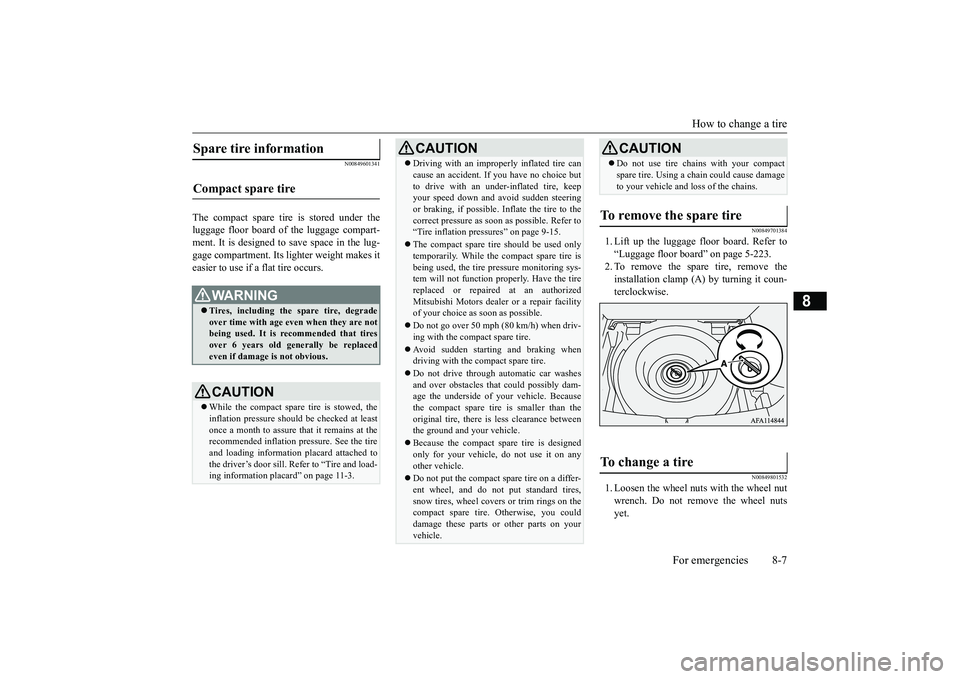
How to change a tire
For emergencies 8-7
8
N00849601341
The compact spare tire is stored under the luggage floor board of the luggage compart-ment. It is designed to save space in the lug- gage compartment. Its lighter weight makes it easier to use if a flat tire occurs.
N00849701384
1. Lift up the luggage floor board. Refer to“Luggage floor board” on page 5-223.2. To remove the spare tire, remove theinstallation clamp (A) by turning it coun- terclockwise.
N00849801532
1. Loosen the wheel nuts with the wheel nut wrench. Do not remove the wheel nuts yet.
Spare tire information Compact spare tire
WA R N I N G Tires, including the spare tire, degrade over time with age even when they are notbeing used. It is recommended that tires over 6 years old generally be replaced even if damage is not obvious.CAUTION While the compact spare tire is stowed, the inflation pressure should be checked at least once a month to assure that it remains at therecommended inflation pressure. See the tire and loading information placard attached to the driver’s door sill. Refer to “Tire and load- ing information placard” on page 11-3.
Driving with an improperly inflated tire can cause an accident. If you have no choice but to drive with an under-inflated tire, keep your speed down and avoid sudden steering or braking, if possible
. Inflate the tire to the
correct pressure as soon as possible. Refer to “Tire inflation pressures” on page 9-15. The compact spare tire should be used only temporarily. While the compact spare tire is being used, the tire pressure monitoring sys-tem will not function properly. Have the tire replaced or repaired at an authorized Mitsubishi Motors dealer or a repair facilityof your choice as soon as possible. Do not go over 50 mph (80 km/h) when driv- ing with the compact spare tire. Avoid sudden starting and braking when driving with the compact spare tire. Do not drive through automatic car washes and over obstacles that could possibly dam- age the underside of your vehicle. Because the compact spare tire is smaller than theoriginal tire, there is less clearance between the ground and your vehicle. Because the compact spare tire is designed only for your vehicle, do not use it on any other vehicle. Do not put the compact spare tire on a differ- ent wheel, and do not put standard tires, snow tires, wheel covers or trim rings on the compact spare tire. Otherwise, you coulddamage these parts or other parts on your vehicle.CAUTION
Do not use tire chains with your compact spare tire. Using a chain could cause damage to your vehicle and loss of the chains.
To remove the spare tire To change a tire
CAUTION
BK0252700US.bo
ok 7 ページ 2017年10月4日 水曜日 午後4時54分
Page 353 of 417
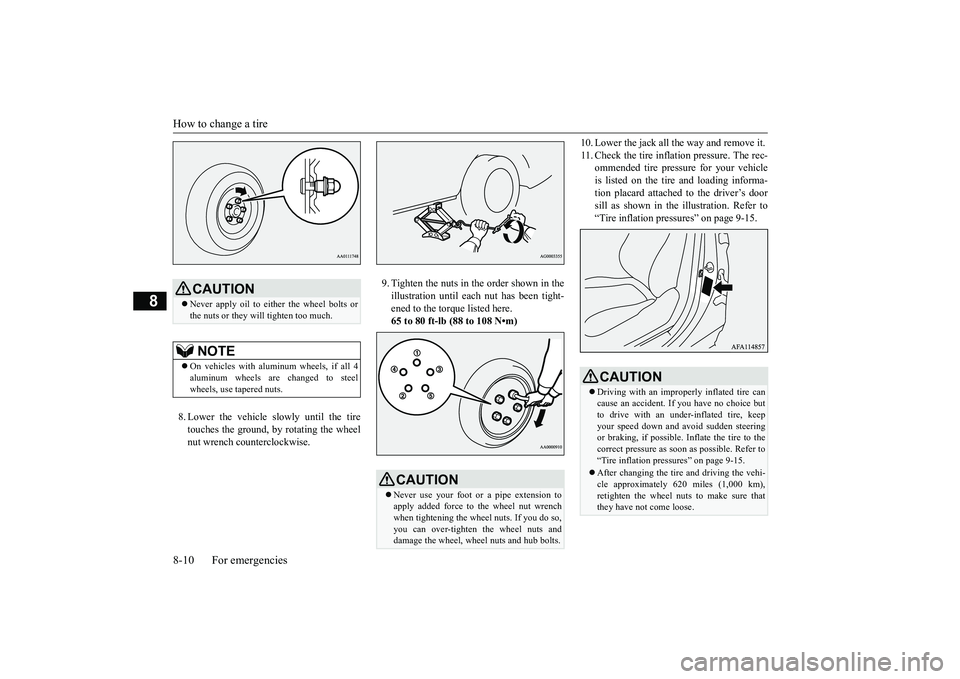
How to change a tire 8-10 For emergencies
8
8. Lower the vehicle slowly until the tire touches the ground, by rotating the wheel nut wrench counterclockwise.
9. Tighten the nuts in the order shown in the illustration until each nut has been tight- ened to the torque listed here.65 to 80 ft-lb (88 to 108 N•m)
10. Lower the jack all the way and remove it. 11. Check the tire inflation pressure. The rec-
ommended tire pressure for your vehicle is listed on the tire and loading informa-tion placard attached to the driver’s door sill as shown in the illustration. Refer to “Tire inflation pressures” on page 9-15.
CAUTION Never apply oil to either the wheel bolts or the nuts or they will tighten too much.NOTE
On vehicles with aluminum wheels, if all 4 aluminum wheels are changed to steel wheels, use tapered nuts.
CAUTION Never use your foot or a pipe extension to apply added force to the wheel nut wrenchwhen tightening the wheel nuts. If you do so, you can over-tighten the wheel nuts and damage the wheel, wheel nuts and hub bolts.
CAUTION Driving with an improperly inflated tire can cause an accident. If
you have no choice but
to drive with an under-inflated tire, keep your speed down and avoid sudden steering or braking, if possible
. Inflate the tire to the
correct pressure as soon as possible. Refer to “Tire inflation pressures” on page 9-15. After changing the tire and driving the vehi- cle approximately 620 miles (1,000 km), retighten the wheel nuts to make sure thatthey have not come loose.
BK0252700US.bo
ok 10 ページ 2017年10月4日 水曜日 午後4時54分
Page 360 of 417
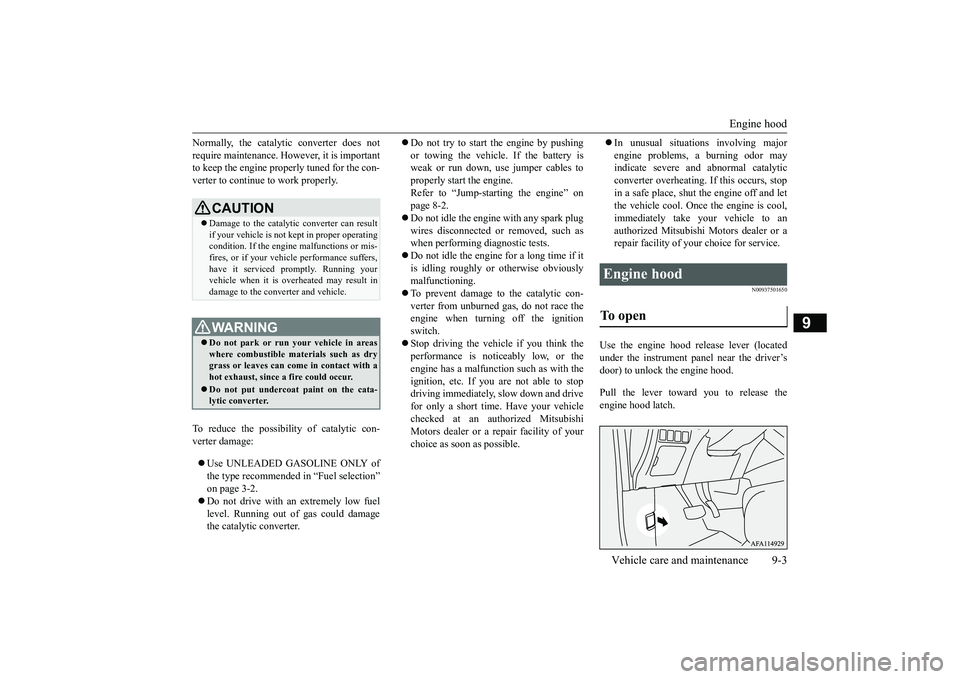
Engine hood
Vehicle care and maintenance 9-3
9
Normally, the catalytic converter does not require maintenance. However, it is important to keep the engine properly tuned for the con- verter to continue to work properly. To reduce the possibility of catalytic con- verter damage: Use UNLEADED GASOLINE ONLY of the type recommended in “Fuel selection” on page 3-2. Do not drive with an extremely low fuel level. Running out of gas could damage the catalytic converter.
Do not try to start the engine by pushing or towing the vehicle. If the battery is weak or run down, use jumper cables to properly start the engine.Refer to “Jump-starting the engine” on page 8-2. Do not idle the engine with any spark plug wires disconnected or removed, such as when performing diagnostic tests. Do not idle the engine for a long time if it is idling roughly or otherwise obviouslymalfunctioning. To prevent damage to the catalytic con- verter from unburned gas, do not race theengine when turning off the ignition switch. Stop driving the vehicle if you think the performance is noticeably low, or the engine has a malfunction such as with the ignition, etc. If you
are not able to stop
driving immediately, slow down and drive for only a short time. Have your vehicle checked at an authorized MitsubishiMotors dealer or a repair facility of your choice as soon as possible.
In unusual situations involving major engine problems, a burning odor may indicate severe and abnormal catalytic converter overheating. If this occurs, stopin a safe place, shut the engine off and let the vehicle cool. Once the engine is cool, immediately take your vehicle to anauthorized Mitsubishi Motors dealer or a repair facility of your choice for service.
N00937501650
Use the engine hood release lever (located under the instrument panel near the driver’s door) to unlock the engine hood. Pull the lever toward you to release the engine hood latch.
CAUTION Damage to the catalytic converter can result if your vehicle is not kept in proper operatingcondition. If the engine malfunctions or mis- fires, or if your vehicle performance suffers, have it serviced promptly. Running yourvehicle when it is overheated may result in damage to the converter and vehicle.WA R N I N G Do not park or run your vehicle in areas where combustible materials such as dry grass or leaves can come in contact with a hot exhaust, since a fire could occur. Do not put undercoat paint on the cata- lytic converter.
Engine hood To open
BK0252700US.bo
ok 3 ページ 2017年10月4日 水曜日 午後4時54分
Page 379 of 417
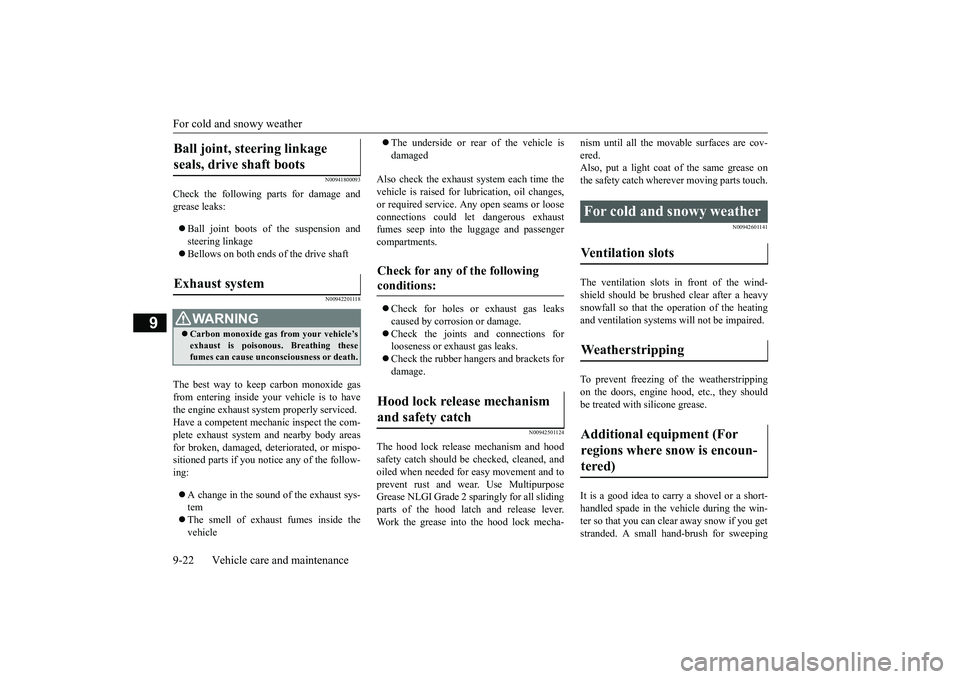
For cold and snowy weather 9-22 Vehicle care and maintenance
9
N00941800093
Check the following parts for damage and grease leaks: Ball joint boots of the suspension and steering linkage Bellows on both ends of the drive shaft
N00942201118
The best way to keep carbon monoxide gas from entering inside your vehicle is to have the engine exhaust system properly serviced. Have a competent mechanic inspect the com-plete exhaust system and nearby body areas for broken, damaged, deteriorated, or mispo- sitioned parts if you notice any of the follow-ing: A change in the sound of the exhaust sys- tem The smell of exhaust fumes inside the vehicle
The underside or rear of the vehicle is damaged
Also check the exhaust system each time the vehicle is raised for lubrication, oil changes, or required service. Any open seams or looseconnections could let dangerous exhaust fumes seep into the luggage and passenger compartments. Check for holes or exhaust gas leaks caused by corrosion or damage. Check the joints and connections for looseness or exhaust gas leaks. Check the rubber hangers and brackets for damage.
N00942501124
The hood lock release mechanism and hood safety catch should be checked, cleaned, and oiled when needed for easy movement and toprevent rust and wear. Use Multipurpose Grease NLGI Grade 2 spar
ingly for all sliding
parts of the hood latch and release lever.Work the grease into the hood lock mecha-
nism until all the movable surfaces are cov- ered. Also, put a light coat of the same grease on the safety catch wherever moving parts touch.
N00942601141
The ventilation slots in front of the wind- shield should be brushed clear after a heavy snowfall so that the operation of the heatingand ventilation systems will not be impaired. To prevent freezing of the weatherstripping on the doors, engine hood, etc., they should be treated with silicone grease. It is a good idea to carry a shovel or a short- handled spade in the vehicle during the win- ter so that you can clear away snow if you get stranded. A small hand-brush for sweeping
Ball joint, steering linkage seals, drive shaft boots Exhaust system
WA R N I N G Carbon monoxide gas from your vehicle’s exhaust is poisonous. Breathing these fumes can cause unconsciousness or death.
Check for any of the following conditions: Hood lock release mechanism and safety catch
For cold and snowy weather Ventilation slots Weatherstripping Additional equipment (For regions where snow is encoun-tered)
BK0252700US.bo
ok 22 ページ 2017年10月4日 水曜日 午後4時54分
Page 381 of 417
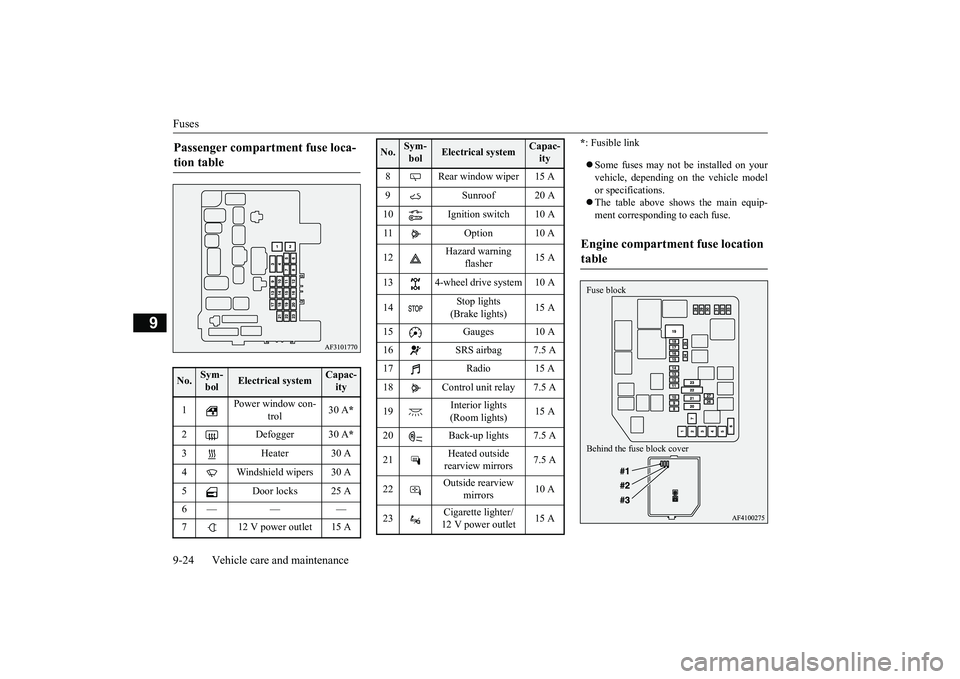
Fuses 9-24 Vehicle care and maintenance
9
* : Fusible link Some fuses may not be installed on your vehicle, depending on the vehicle model or specifications. The table above shows the main equip- ment corresponding to each fuse.
Passenger compartment fuse loca- tion table No.
Sym- bol
Electrical system
Capac-ity
1
Power window con-
trol
30 A
*
2 Defogger 30 A
*
3 Heater 30 A 4 Windshield wipers 30 A 5 Door locks 25 A 6— — — 7 12 V power outlet 15 A
8 Rear window wiper 15 A 9 Sunroof 20 A 10 Ignition switch 10 A 11 Option 10 A 12
Hazard warning
flasher
15 A
13 4-wheel drive system 10 A14
Stop lights (Brake lights)
15 A
15 Gauges 10 A 16 SRS airbag 7.5 A 17 Radio 15 A 18 Control unit relay 7.5 A 19
Interior lights (Room lights)
15 A
20 Back-up lights 7.5 A21
Heated outside rearview mirrors
7.5 A
22
Outside rearview
mirrors
10 A
23
Cigarette lighter/ 12 V power outlet
15 A
No.
Sym- bol
Electrical system
Capac-ity
Engine compartment fuse location table Behind the fuse block cover Fuse block
BK0252700US.bo
ok 24 ページ 2017年10月4日 水曜日 午後4時54分
Page 392 of 417
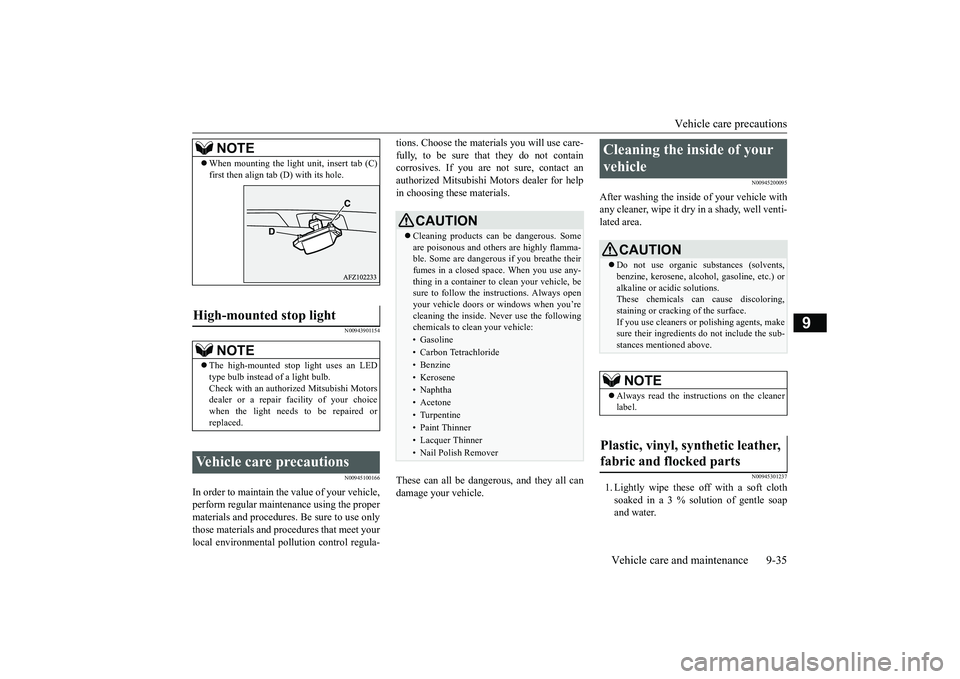
Vehicle care precautions
Vehicle care and maintenance 9-35
9
N00943901154 N00945100166
In order to maintain the value of your vehicle, perform regular maintenance using the proper materials and procedures. Be sure to use onlythose materials and procedures that meet your local environmental pollution control regula-
tions. Choose the materials you will use care- fully, to be sure that they do not contain corrosives. If you are not sure, contact an authorized Mitsubishi Motors dealer for helpin choosing these materials. These can all be dangerous, and they all can damage your vehicle.
N00945200095
After washing the inside of your vehicle withany cleaner, wipe it dry in a shady, well venti-lated area.
N00945301237
1. Lightly wipe these off with a soft clothsoaked in a 3 % solution of gentle soap and water.
NOTE
When mounting the light unit, insert tab (C) first then align tab (D) with its hole.
High-mounted stop light
NOTE
The high-mounted stop light uses an LED type bulb instead of a light bulb. Check with an authorized Mitsubishi Motors dealer or a repair
facility of your choice
when the light needs to be repaired or replaced.
Vehicle care precautions
CAUTION Cleaning products can be dangerous. Some are poisonous and others are highly flamma- ble. Some are dangerous if you breathe theirfumes in a closed space. When you use any- thing in a container to clean your vehicle, be sure to follow the instructions. Always openyour vehicle doors or windows when you’re cleaning the inside. Never use the following chemicals to clean your vehicle:• Gasoline• Carbon Tetrachloride• Benzine• Kerosene• Naphtha• Acetone• Turpentine• Paint Thinner• Lacquer Thinner• Nail Polish Remover
Cleaning the inside of your vehicle
CAUTION Do not use organic substances (solvents, benzine, kerosene, alcohol, gasoline, etc.) or alkaline or acidic solutions.These chemicals can cause discoloring, staining or cracking of the surface. If you use cleaners or polishing agents, makesure their ingredients do not include the sub- stances mentioned above.NOTE
Always read the instructions on the cleaner label.
Plastic, vinyl, synthetic leather, fabric and flocked parts
BK0252700US.bo
ok 35 ページ 2017年10月4日 水曜日 午後4時54分
Page 406 of 417
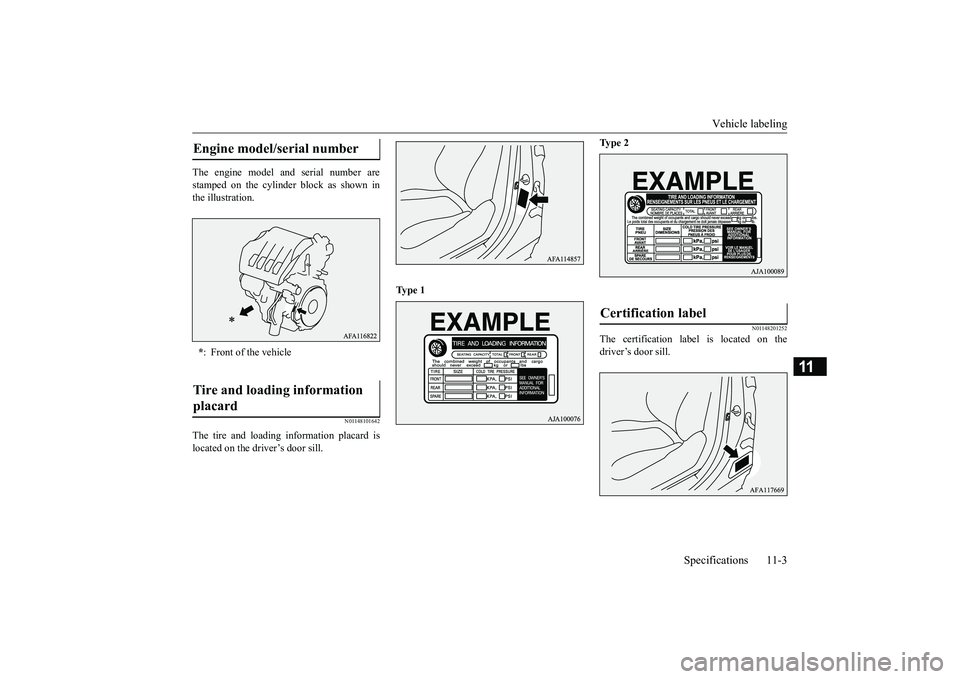
Vehicle labeling
Specifications 11-3
11
The engine model and serial number are stamped on the cylinder block as shown in the illustration.
N01148101642
The tire and loading information placard is located on the driver’s door sill.
Ty p e 1
Ty p e 2
N01148201252
The certification label is located on the driver’s door sill.
Engine model/serial number * : Front of the vehicleTire and loading information placard
Certification label
BK0252700US.bo
ok 3 ページ 2017年10月4日 水曜日 午後4時54分
Page 412 of 417
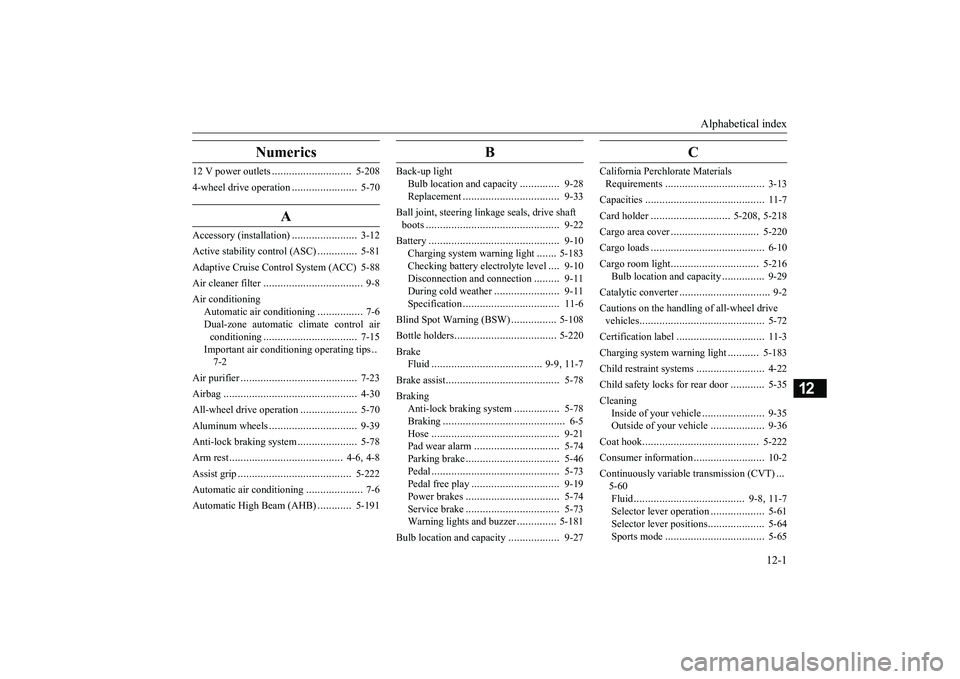
Alphabetical index
12-1
12
Numerics
12 V power outlets
............................
5-208
4-wheel drive operation
.......................
5-70
A
Accessory (installation)
.......................
3-12
Active stability control (ASC)
..............
5-81
Adaptive Cruise Control System (ACC) 5-88 Air cleaner filter
...................
................
9-8
Air conditioning
Automatic air conditioning
................
7-6
Dual-zone automatic climate control airconditioning
................
.................
7-15
Important air conditioning operating tips
..
7-2
Air purifier
....................
.....................
7-23
Airbag
.......................
........................
4-30
All-wheel drive operation
....................
5-70
Aluminum wheels
...............................
9-39
Anti-lock braking system
.....................
5-78
Arm rest
.....................
...................
4-6
, 4-8
Assist grip
.....................
...................
5-222
Automatic air conditioning
....................
7-6
Automatic High Beam (AHB)
............
5-191
B
Back-up light
Bulb location and capacity
..............
9-28
Replacement
...................
...............
9-33
Ball joint, steering linkage seals, drive shaft boots
.........................
......................
9-22
Battery
........................
......................
9-10
Charging system warning light
.......
5-183
Checking battery electrolyte level
....
9-10
Disconnection and connection
.........
9-11
During cold weather
.......................
9-11
Specification
...................
...............
11-6
Blind Spot Warning (BSW)
................
5-108
Bottle holders
...................
.................
5-220
Brake
Fluid
....................
...................
9-9
, 11-7
Brake assist
......................
..................
5-78
Braking
Anti-lock braking system
................
5-78
Braking
.......................
....................
6-5
Hose
.......................
......................
9-21
Pad wear alarm
...............
...............
5-74
Parking brake
..................
...............
5-46
Pedal
.......................
......................
5-73
Pedal free play
................
...............
9-19
Power brakes
..................
...............
5-74
Service brake
..................
...............
5-73
Warning lights and buzzer
..............
5-181
Bulb location and capacity
..................
9-27
C
California Perchlorate Materials Requirements
..................
.................
3-13
Capacities
.....................
.....................
11-7
Card holder
............................
5-208
, 5-218
Cargo area cover
................
...............
5-220
Cargo loads
...................
.....................
6-10
Cargo room light
................
...............
5-216
Bulb location and capacity
...............
9-29
Catalytic converter
................
................
9-2
Cautions on the handling of all-wheel drive vehicles
.......................
.....................
5-72
Certification label
...............................
11-3
Charging system warning light
...........
5-183
Child restraint systems
........................
4-22
Child safety locks for rear door
............
5-35
Cleaning
Inside of your vehicle
......................
9-35
Outside of your vehicle
...................
9-36
Coat hook
......................
...................
5-222
Consumer information
.........................
10-2
Continuously variable transmission (CVT)
...
5-60 Fluid
..................
.....................
9-8
, 11-7
Selector lever operation
...................
5-61
Selector lever positions
....................
5-64
Sports mode
..................
.................
5-65
BK0252700US.bo
ok 1 ページ 2017年10月4日 水曜日 午後4時54分
Page 413 of 417
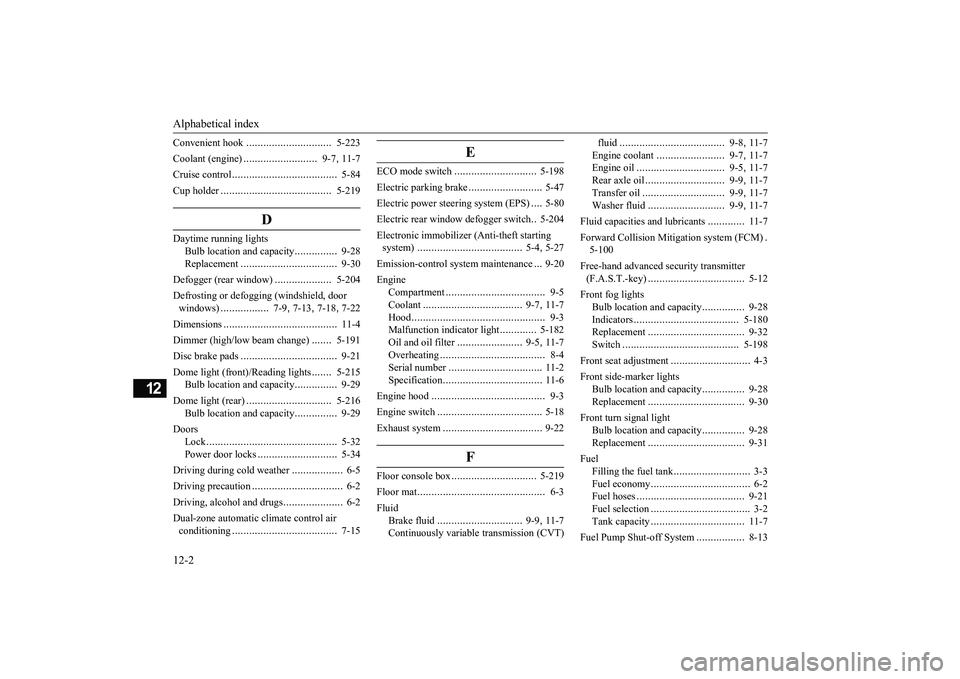
Alphabetical index 12-2
12
Convenient hook
...............
...............
5-223
Coolant (engine)
..........................
9-7
, 11-7
Cruise control
....................
.................
5-84
Cup holder
....................
...................
5-219
D
Daytime running lights
Bulb location and capacity
...............
9-28
Replacement
.................
.................
9-30
Defogger (rear window)
....................
5-204
Defrosting or defogging (windshield, door windows)
.................
7-9
, 7-13
, 7-18
, 7-22
Dimensions
...................
.....................
11-4
Dimmer (high/low beam change)
.......
5-191
Disc brake pads
.................
.................
9-21
Dome light (front)/Reading lights
.......
5-215
Bulb location and capacity
...............
9-29
Dome light (rear)
...............
...............
5-216
Bulb location and capacity
...............
9-29
Doors
Lock
......................
........................
5-32
Power door locks
............................
5-34
Driving during cold weather
..................
6-5
Driving precaution
................
................
6-2
Driving, alcohol and drugs
.....................
6-2
Dual-zone automatic climate control air conditioning
....................
.................
7-15
E
ECO mode switch
.............................
5-198
Electric parking brake
..........................
5-47
Electric power steering system (EPS)
....
5-80
Electric rear window defogger switch
..5-204
Electronic immobilizer (Anti-theft starting system)
.....................
................
5-4
, 5-27
Emission-control system maintenance
...
9-20
Engine
Compartment
..................
.................
9-5
Coolant
...................
................
9-7
, 11-7
Hood
.......................
........................
9-3
Malfunction indicator light
.............
5-182
Oil and oil filter
.......................
9-5
, 11-7
Overheating
....................
.................
8-4
Serial number
.................
................
11-2
Specification
...................
................
11-6
Engine hood
....................
....................
9-3
Engine switch
.....................
................
5-18
Exhaust system
...................
................
9-22
F
Floor console box
..............................
5-219
Floor mat
.........................
....................
6-3
Fluid
Brake fluid
..............................
9-9
, 11-7
Continuously variable transmission (CVT)
fluid
....................
.................
9-8
, 11-7
Engine coolant
........................
9-7
, 11-7
Engine oil
...............................
9-5
, 11-7
Rear axle oil
............................
9-9
, 11-7
Transfer oil
.............................
9-9
, 11-7
Washer fluid
...........................
9-9
, 11-7
Fluid capacities and lubricants
.............
11-7
Forward Collision Mitigation system (FCM)
.
5-100 Free-hand advanced security transmitter (F.A.S.T.-key)
.................
.................
5-12
Front fog lights
Bulb location and capacity
...............
9-28
Indicators
..................
...................
5-180
Replacement
.................
.................
9-32
Switch
......................
...................
5-198
Front seat adjustment
............................
4-3
Front side-marker lights
Bulb location and capacity
...............
9-28
Replacement
.................
.................
9-30
Front turn signal light
Bulb location and capacity
...............
9-28
Replacement
.................
.................
9-31
Fuel
Filling the fuel tank
...........................
3-3
Fuel economy
...................
................
6-2
Fuel hoses
.....................
.................
9-21
Fuel selection
...................
................
3-2
Tank capacity
................
.................
11-7
Fuel Pump Shut-off System
.................
8-13
BK0252700US.bo
ok 2 ページ 2017年10月4日 水曜日 午後4時54分